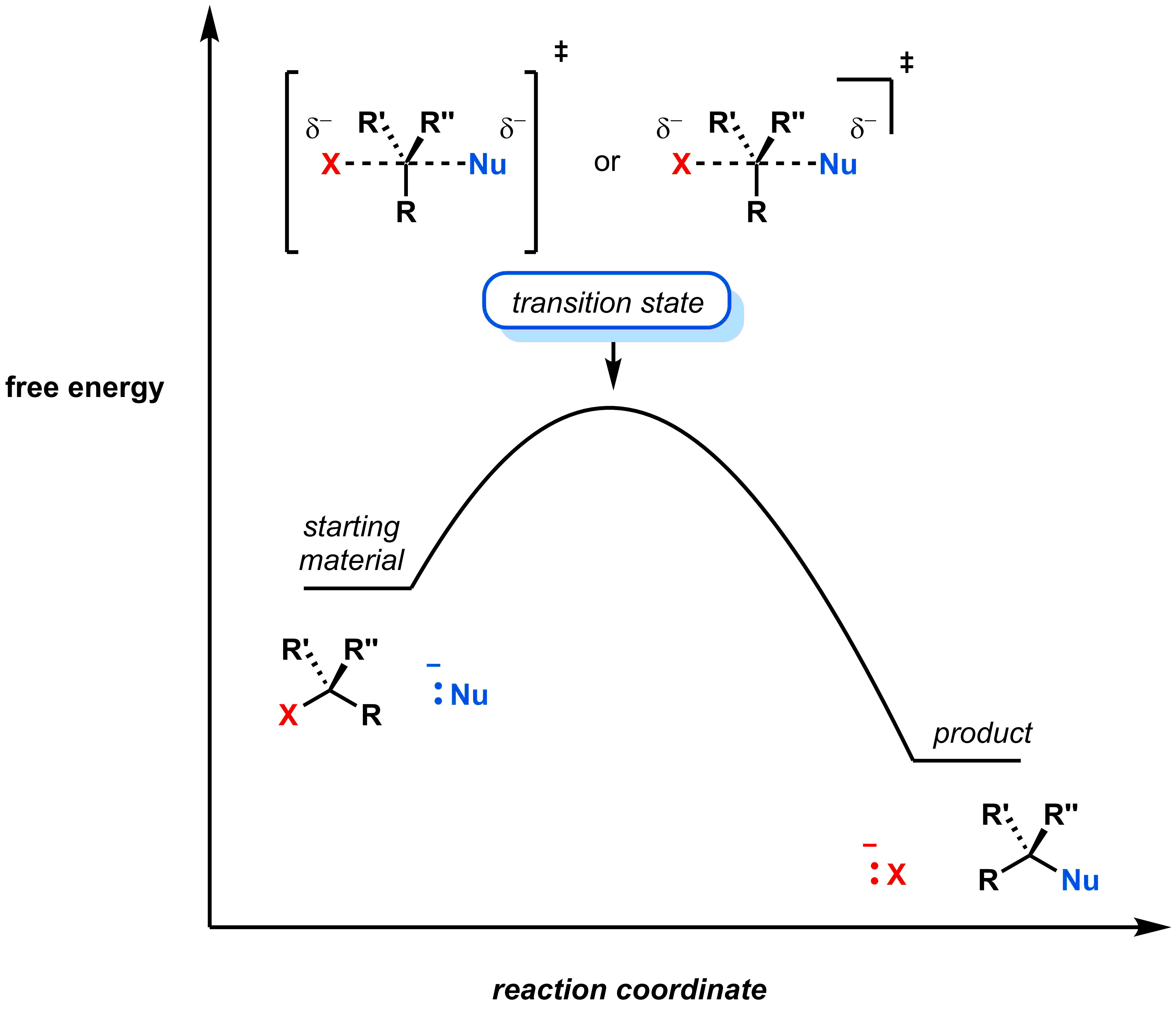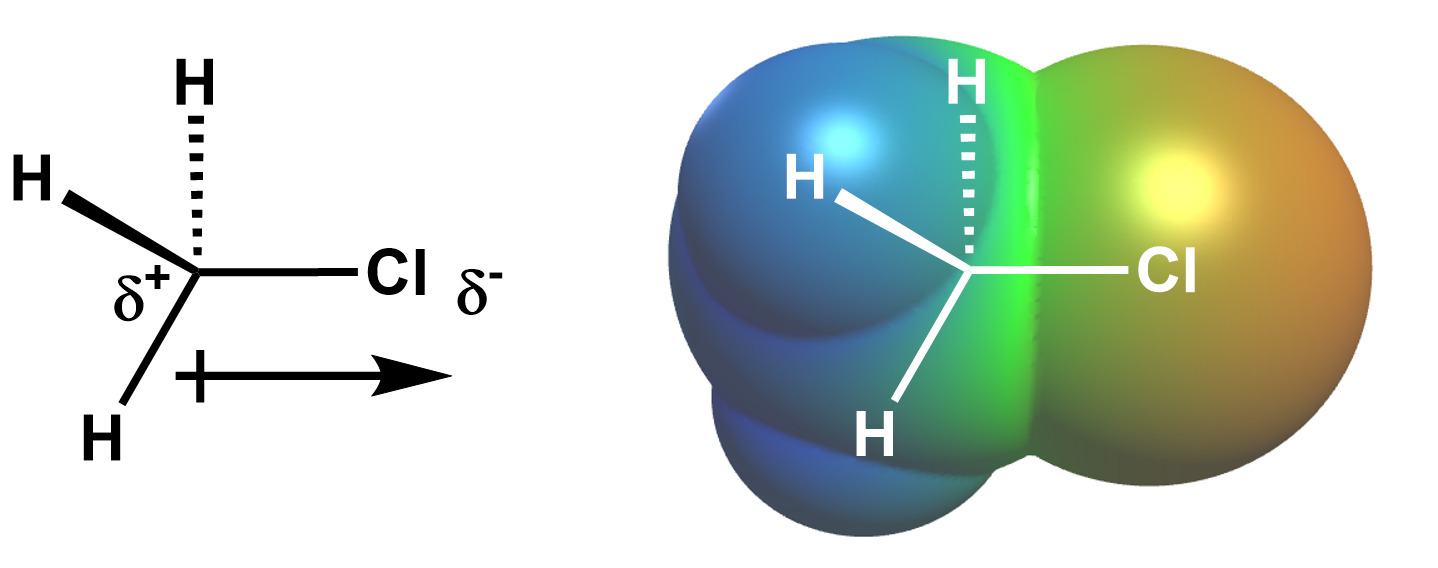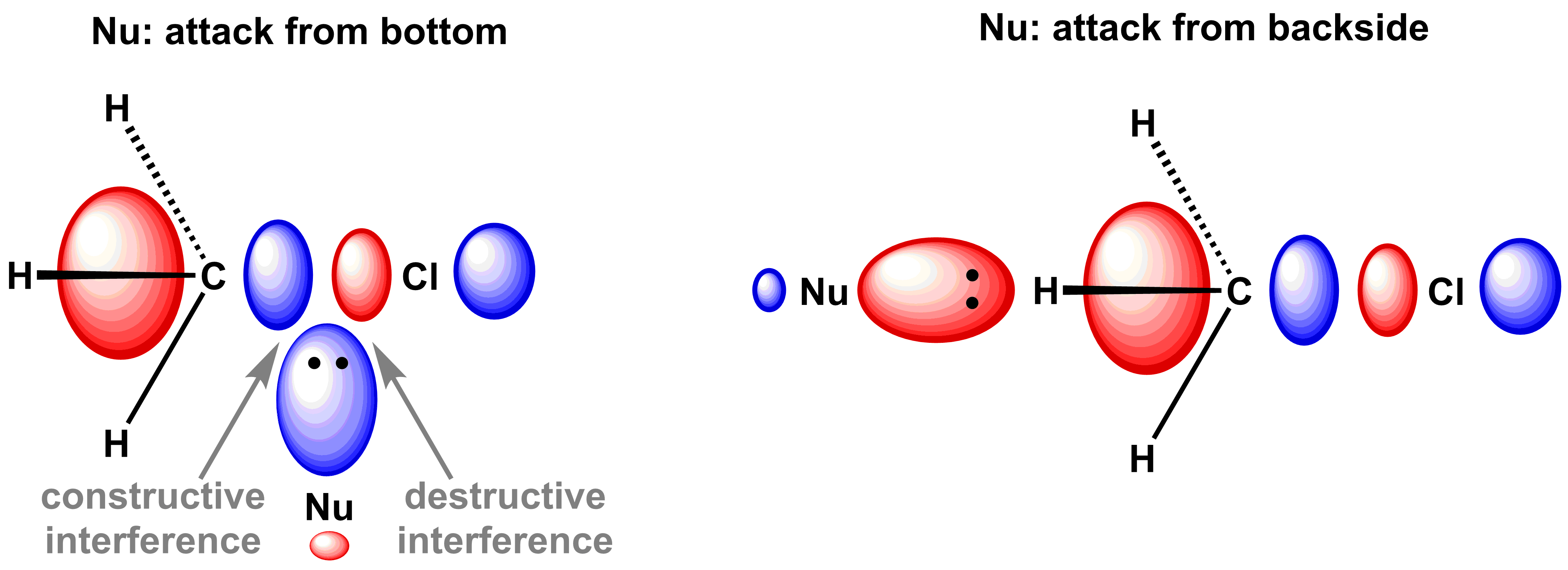In an SN2 reaction:
- The mechanism occurs in a single elementary step.
- The reactive carbon in the electrophile is the one directly bonded to the leaving group.
- The nucleophile approaches the electrophile from the side opposite to the leaving group.
- The kinetics follow the same principles as a standard bimolecular elementary reaction.
Mechanism
Substitution reactions are subdivided into different types based on their mechanism. In this section, we are focusing on a second order, nucleophilic substitution reaction (SN2). An SN2 reaction occurs through a concerted reaction mechanism, in which all bonds are formed and broken in a single step. As the entire process occurs in a single step, the overall reaction can be depicted as the single elementary step, as shown in the scheme below:

Curved arrows: The curved arrow formalism is a very useful method to keep track of the movement of electrons in a chemical reaction. An arrow from a lone pair to an atom indicates the donation of both electrons in the lone pair to the formation of a new bond. The movement from a bond to an atom indicates the bond is breaking and a new lone pair is formed. In the mechanism depicted below, the larger curved arrow shows the electrons from Nu:- (the nucleophile) moving towards the central carbon (on the electrophile) to form a new bond. This new bond is shown in blue on the product side. The second, smaller curved arrow shows that the bond between the central C and X breaks, and the electrons end up on X (the leaving group). Both curved arrows are drawn in the same step, since bond breaking and bond formation are simultaneous in the SN2 mechanism.


View solution:

The red arrow shows how the red bond on the reactant side breaks. These electrons end up on the bromide on the product side. The blue arrow shows how the blue bond on the product side forms. A pair of electrons in iodide is shared with the reactive carbon.
Transition state: A transition state is the highest energy point in an elementary reaction. As transition states are not energy minima, they cannot be isolated. The diagram below shows a generic SN2 reaction, in which the reactant and reagents are listed on the left and the products are depicted on the right. As an SN2 reaction is a concerted process, there is only a single transition state. Transition states are typically drawn with brackets (or with a corner mark at the top right) and labeled with a double dagger (ǂ), to indicate that it is a transition state. Dotted lines in transition states indicate that the bond is partially formed or partially broken.

The video below shows a substitution reaction as it follows the SN2 mechanism. As mentioned above, the dotted lines in the video represent partially formed/broken bonds. As the bond between NC- and the central C forms, the bond between the central C and Br breaks. In the process the CH3 and two H's 'swing' from the left side to the right side. The transition state occurs when these groups are halfway through their 'swing' and the bonds are partially formed/broken. The transition state has a trigonal bipyramidal shape.
|
|
Electron Distribution: All of the examples above show how an SN2 process proceeds, but it does not indicate why the process occurs. Much of this reaction can be understood through the charge distributions of the (1) nucleophile, (2) the electrophile, and (3) the leaving group.
- Nucleophile: For this class, a nucleophile in an SN2 reaction always possesses a lone pair of electrons. This is necessary as 2 electrons are required to form a sigma bond with the electrophile. Often, a nucleophile will have a negative charge to increase the reaction rate with the electron deficient (i.e. partially positively charged) electrophilic centre.
- Electrophile: As indicated in the Pauling electronegativity scale, the chlorine atom is more electronegative (3.16) than carbon (2.55). The electrons in a chlorine-carbon bond, therefore, are “polarized”, or shifted to the chlorine atom. This results in a higher charge density on the chlorine atom, which we can indicate with a partial negative charge. In turn, the carbon atom bears a partial positive charge. This can be visualized using either a dipole arrow or electrostatic potential map, both of which are shown below.
 Since the nucleophile is negatively (or partially negatively) charged, it is attracted to the partially positively charged carbon next to the leaving group. Thus, in an SN2 reaction, the nucleophile attacks the electrophile carbon directly bonded to the leaving group because the negatively charged nucleophile is attracted to this positively charged carbon.
Since the nucleophile is negatively (or partially negatively) charged, it is attracted to the partially positively charged carbon next to the leaving group. Thus, in an SN2 reaction, the nucleophile attacks the electrophile carbon directly bonded to the leaving group because the negatively charged nucleophile is attracted to this positively charged carbon. - Leaving group: The leaving group in an SN2 reaction is usually an electronegative, or polarizable, atom that can accommodate all of the electrons from the sigma bond between the electrophilic carbon and the leaving group.
Backside attack: You may have noticed in the SN2 mechanism video above that the nucleophile approaches the electrophile exactly opposite to the direction that the leaving group leaves. This approach is called "backside attack" and is true of all SN2 reactions. This can be explained using an analysis of the orbitals that are involved in the process. First, consider the simplified bonding and antibonding molecular orbitals of the carbon-chlorine bond, below.

At the beginning of the SN2 reaction, the chlorine-carbon bond is intact, so there are two electrons in the bonding orbital and no electrons in the antibonding orbital. If the bonding and antibonding orbitals each had two electrons, then there would be no net bond between carbon and chlorine (see Molecular Orbital Theory). Thus, to break the carbon-chlorine bond during the SN2 reaction, the nucleophile must donate two electrons into the chlorine-carbon antibonding orbital. We already know that the nucleophile is attracted to the carbon (see above), so it will add its electrons to one of the two antibonding orbital lobes closest to the carbon. The nucleophile cannot approach the blue lobe on carbon from the right, since the chlorine atom is in the way. It could either approach the blue lobe from the bottom (or equivalently the top) or the large red lobe from the backside (left in this case), as shown below. We can see that if the nucleophile approaches from the bottom (or top) there will be no net interaction, since there are both constructive and destructive interactions. If the nucleophile approaches from the backside (i.e. opposite to the leaving group), it has good constructive interference with the red antibonding orbital lobe on carbon. Thus, in SN2 reactions, nucleophiles always approach the electrophile from the direction opposite the leaving group ("backside attack").

Kinetics
The SN2 reaction happens in a single step and is, therefore, an elementary reaction. With this information, you can determine the kinetics of SN2 reactions using your previous knowledge. Complete the activities below to see how your knowledge of kinetics applies to the SN2 mechanism.
Guided:
Note: the interactive components of this tutorial require html5 video, which is not supported by some mobile devices (e.g. iPhones). This tutorial is best viewed on a computer.
Interactive: